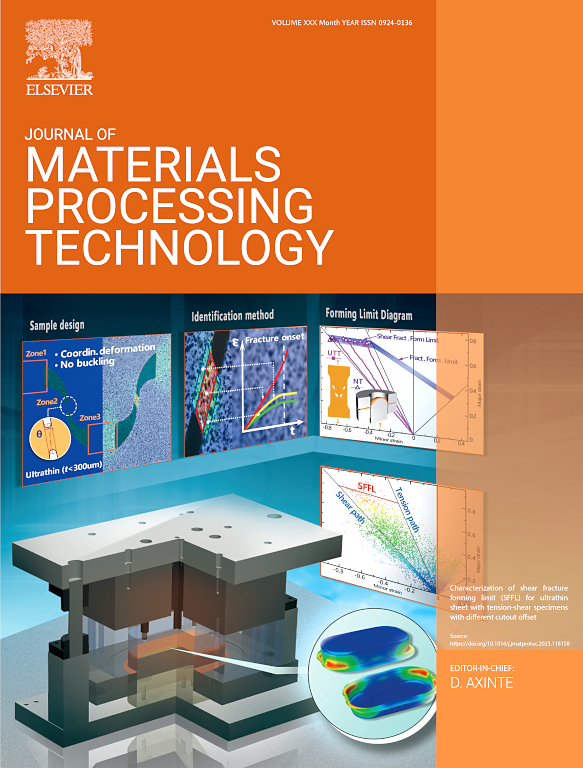液体诱导愈合策略消除激光粉末床熔合合金中气体夹带的熔合不足
IF 6.7
2区 材料科学
Q1 ENGINEERING, INDUSTRIAL
Journal of Materials Processing Technology
Pub Date : 2025-06-13
DOI:10.1016/j.jmatprotec.2025.118936
引用次数: 0
摘要
阻碍金属增材制造广泛应用的一个关键挑战在于工艺引起的缺陷,这些缺陷会损害制造部件的结构完整性和机械性能。其中,熔合不足(LoF)缺陷最为普遍,其特征是气体夹持、体积大、形态不规则。这项工作报告了一项基本的工艺进步:液体诱导愈合(LIH)技术独特地将浮力驱动的气体排出与受控的晶粒粗化结合在一起,同时消除了激光粉末床熔合部件的缺陷并提高了高温性能。以激光粉末床熔合制备的IN718为示范合金,系统地评价了缺陷愈合机制及其对显微组织和力学性能的影响。结果表明,LIH使材料的相对密度从97.99 %提高到99.97 %,650℃时的拉伸伸长率提高了1.8倍,而材料强度仅降低了约10 %。疲劳性能(25℃,σmax = 950 MPa)提高了3.4倍。更重要的是,由于缺陷修复和微观组织调节同时进行,蠕变寿命(650℃,650 MPa)提高了6.5倍。最根本的进步是LIH的集成重熔机制,同时实现了气体排出和微观结构优化,建立了修复缺陷的新途径,同时决定性地解决了激光束粉末床熔合部件长期存在的蠕变寿命不足。本文章由计算机程序翻译,如有差异,请以英文原文为准。
Strategic elimination of gas-entrapped lack-of-fusion in laser beam powder bed fusion alloy via liquid-induced healing
A critical challenge impeding broader application of metal additive manufacturing lies in the process-induced defects that compromise the structural integrity and mechanical properties of fabricated components. Among these, lack-of-fusion (LoF) defects are the most prevalent, characterized by gas entrapment, large volumes, and irregular morphologies. This work reports a fundamental process advancement: the liquid-induced healing (LIH) technique uniquely integrates buoyancy-driven gas expulsion with controlled grain coarsening to simultaneously eliminate defects and enhance high-temperature performance in laser beam powder bed fusion components. Using laser beam powder bed fusion fabricated IN718 as the demonstration alloy, we systematically evaluate the defect healing mechanism and its effects on microstructure and mechanical properties. The results show that LIH increases the relative density from 97.99 % to 99.97 % and improves tensile elongation at 650°C by 1.8 times, with only an approximate 10 % reduction in material strength. Notably, the fatigue performance (25°C, σmax = 950 MPa) demonstrates a 3.4 times extended lifetime. More importantly, the creep life (650°C, 650 MPa) increases by 6.5 times owing to the simultaneous defect healing and microstructure regulation. The fundamental advancement is LIH’s integrated remelting mechanism that concurrently enables gas evacuation and microstructural optimization, establishing a new pathway to heal defects while decisively addressing the long-standing creep life deficiency in laser beam powder bed fusion components.
求助全文
通过发布文献求助,成功后即可免费获取论文全文。
去求助
来源期刊

Journal of Materials Processing Technology
工程技术-材料科学:综合
CiteScore
12.60
自引率
4.80%
发文量
403
审稿时长
29 days
期刊介绍:
The Journal of Materials Processing Technology covers the processing techniques used in manufacturing components from metals and other materials. The journal aims to publish full research papers of original, significant and rigorous work and so to contribute to increased production efficiency and improved component performance.
Areas of interest to the journal include:
• Casting, forming and machining
• Additive processing and joining technologies
• The evolution of material properties under the specific conditions met in manufacturing processes
• Surface engineering when it relates specifically to a manufacturing process
• Design and behavior of equipment and tools.
 求助内容:
求助内容: 应助结果提醒方式:
应助结果提醒方式:


